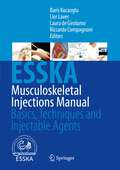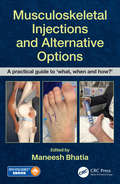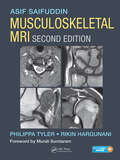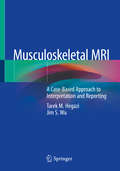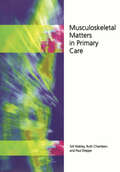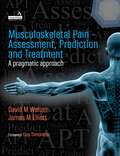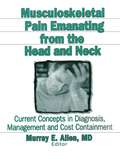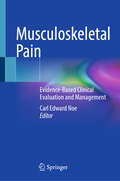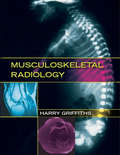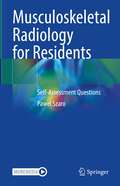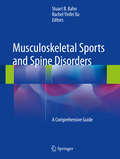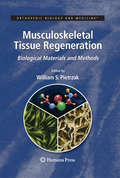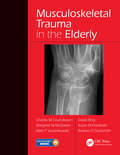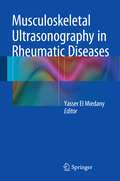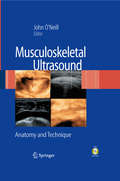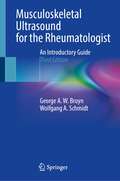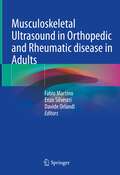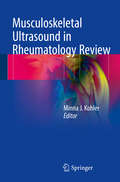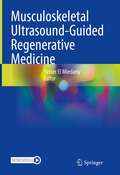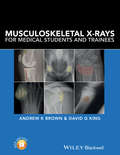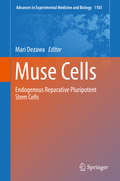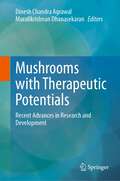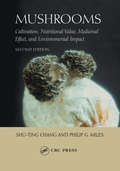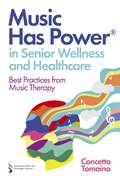- Table View
- List View
Musculoskeletal Injections Manual: Basics, Techniques and Injectable Agents
by Lior Laver Baris Kocaoglu Laura De Girolamo Riccardo CompagnoniThis book presents a comprehensive and updated overview of musculoskeletal injections with biologic and non-biologic injectable agents – a new trend of treatment in orthopaedics and sports medicine.This ESSKA book incorporates internal ongoing debates fostered by ESSKA U45 Committee and ESSKA’s Orthobiologics Initiative (ORBIT), which enroll a broad international group of dedicated clinicians and researchers. The topics covered mirror this fast evolving field which ranges from basic science knowledge to treatment options in sports traumatology. Renowned experts in the field examine and critically discuss each aspect, including existing controversies concerning indications and applications as well as the choice between biologic and non-biologic injections. Clear practical indications, subdivided by anatomical region and supported by a wealth of intra-procedural images, are aimed to support young surgeons in the application of musculoskeletal injections. Written by an international panel of clinicians and researchers, active in the field of orthobiology and sports medicine, this manual is an invaluable reference tool for all those involved in injectional therapies and sports traumatology.
Musculoskeletal Injections and Alternative Options: A practical guide to 'what, when and how?'
by Maneesh BhatiaMusculoskeletal injections for joint or tendon problems are performed commonly and their use, which can result in a marked improvement in acute symptoms as well as delay or postpone surgery, is on the rise. Key features: Provides concise, current and portable information Covers the latest treatment options, supported by scientific evidence and guidelines Discusses alternative injections, non-injection measures and novel treatment modalities Text supported by illustrations and video of injection procedures and physiotherapy Ideal for both the non-specialist seeking an introduction to the subject and the more experienced practitioner This accessible guide helps doctors from various disciplines including orthopaedics, sports medicine, rheumatology, radiology and primary care as well as allied health care professionals understand the indications and local anatomy to safely perform injections with complication avoidance. In addition, the book provides useful information regarding other alternatives including physiotherapy and novel modalities. The content is supported by current evidence, guidelines and companion videos.
Musculoskeletal MRI
by Asif Saifuddin Philippa Tyler Rikin HargunaniMusculoskeletal MRI covers the entire musculoskeletal system and related conditions, both common and rare. The text is neatly divided into sections based on the major anatomic divisions. Each section discusses anatomic subdivisions or joints, keeping sections on normal anatomy and pathologic findings close to each other, allowing radiologists to easily compare images of normal and pathologic findings. With more than 4000 high-quality MR images, information is presented in an easy-to-read bulleted format, providing the radiologist with all the information required to make an informed diagnosis in the clinical setting. The new edition also includes a complimentary eBook as well as access to image downloads. Comprehensive and user-friendly in its approach, the book provides every radiologist, both consultant and trainee, with increased confidence in their reporting.
Musculoskeletal MRI: A Case-Based Approach to Interpretation and Reporting
by Jim S. Wu Tarek M. HegaziThis book teaches readers how to interpret, read, and dictate musculoskeletal (MSK) MRI studies through a series of very high yield MSK MRI cases. The amount of knowledge needed to practice radiology can be daunting. This is especially true when the radiologist has to read studies in a subspecialty outside their expertise such as MSK MRI where there are numerous disease entities and complex imaging findings to navigate. Learning how to read MSK MRI studies is often taught during a lengthy fellowship; however, many radiologists do not have this additional training but must read MSK studies during their routine clinical practice. This book fills that educational gap for practicing radiologists faced with musculoskeletal MRIs. The cases in the book focus on the conditions that radiologists encounter most frequently in their daily clinical work, making it very high yield for the amount of time needed to read it. Written by experts from Harvard Medical School, the cases are organized by joints (shoulder, elbow, wrist/hand, pelvis/hip, knee, foot/ankle). Four additional chapters discussing arthritis, infection, bone marrow and tumors are also included. Each case begins with carefully selected high quality MRI images accompanied by a brief clinical vignette. Next, a concise report (as if one is dictating an official report) describing the imaging findings, diagnosis, and recommendations for management are provided. This sample dictation offers readers direct examples of how to report their own cases. Lastly, at the end of each case, there is a brief discussion section which mimics teaching sessions that would occur between specialist trainees and faculty members at the workstation so as to enable the readers to think like a bone radiologist. This book is an ideal guide for anyone who deals with MSK MRI on a regular basis, including general radiologists who have not completed a dedicated musculoskeletal radiology fellowship, radiologists who would want to brush up on their MSK MRI reading and reporting skills, and MSK radiology fellows and residents.
Musculoskeletal Matters in Primary Care
by Paul Dieppe Ruth Chambers Gill WakleyWidespread recognition of the benefits of minimally invasive procedures in surgery and medicine is resulting in the rapid development of new advances and new techniques in every speciality. This series of books sets out to meet the needs of those responsible for applying the techniques. This volume deals with the field of minimal access gynaecology. Areas covered and techniques described include: advances in instrumentation and equipment for minimal access surgery; operative endoscopy in the treatment of infertility; laparoscopic assisted vaginal hysterectomy and total laparoscopic hysterectomy; advancements in laser fibre optic delivery systems compared to existing electrosurgery techniques; and operative hysteroscopy with electricity.
Musculoskeletal Pain - Assessment, Prediction and Treatment
by David Walton Jim ElliottMusculoskeletal Pain - Assessment, Prediction and Treatment presents a common sense approach to interpreting and applying existing clinical knowledge and new research to help clinicians make sense of the complex phenomena of acute and chronic post-traumatic musculoskeletal pain. Built upon the Assess, Predict, Treat framework, the authors offer a method to help clinicians better understand their patients' pain. They present evidence-based decision tools to predict the natural and clinical course of common conditions, such as neck and low back pain, and they then synthesize that information into a logical, integrated treatment approach, which respects the individuality of the patient, the experiences of the clinician, and the value of evidence-informed practice.David Walton and James Elliott are leaders in the field of post-traumatic pain and recovery. Their work provides a valuable framework to facilitate novice clinicians in their transition towards experts and helps mid- and late-stage clinicians better interpret, synthesize, and discuss complex information on pain with the goal of optimised outcomes for patients.
Musculoskeletal Pain Emanating From the Head and Neck: Current Concepts in Diagnosis, Management, and Cost Containment
by Irwin J Russell Murray E AllenIt has been around since the first rear-impact automobile accident and it will continue to be a problem as long as humans have large, heavy heads perched on slender, highly mobile cervical spines. The subject is whiplash, and some of the brightest minds on the topic gathered in Banff, Alberta, Canada, for the Eighth International Symposium by the Physical Medicine Research Foundation. Editor Dr. Murray E. Allen, Chairman of the Symposium, has collected the findings in Musculoskeletal Pain Emanating From the Head and Neck: Current Concepts in Diagnosis, Management, and Cost Containment to help physicians, physical therapists, chiropractors, and researchers better understand “the new whiplash,” make reliable clinical assessments, and provide more effective treatment.This thorough collection includes bump studies with human volunteers, research into safer automobile seat backs and head restraints, postmortem cervical spine examinations, reviews of the literature, and other investigations from around the world. Readers of Musculoskeletal Pain Emanating From the Head and Neck will learn specifically about: injury mechanisms, threshold for injury, and impact severity long-term outcomes of whiplash injury psychological aspects of chronic pain and disability dizziness, imbalance, and chronic incapacity intervertebral joint injuries and cervical synovial joint injuries the Neck Disability Index manipulation and mobilization therapies temporomandibular disorders/temporomandibular pain and dysfunction syndrome (TMPDS)Musculoskeletal Pain Emanating From the Head and Neck is not simply a collection of studies presenting data and findings--rather, it is a compilation of knowledge that illuminates the challenges of treating whiplash and makes some strong and straightforward recommendations for improvement. The contributors and the editor stress to the reader that in order to provide the best possible care, providers must be alert to the many secondary manifestations of whiplash, test for the perception of dysfunction, and be reassuring whenever possible. They must foster an atmosphere of confidence, encourage very early activation, and help persons maintain the momentum of their lives. Furthermore, Dr. Allen calls for caregivers to stop most (if not all) drug treatments, avoid passive failure-mode treatments, and avoid prolonged medicalization of any form of treatment. By studying the findings and following the recommendations of the international experts contributing to Musculoskeletal Pain Emanating From the Head and Neck, physicians, chiropractors, and physical therapists will foster self-reliance in their patients and improve diagnosis, treatment, and cost containment of whiplash.
Musculoskeletal Pain: Evidence-Based Clinical Evaluation and Management
by Carl Edward NoeThis concise book covers common musculoskeletal problems in all body regions, filling a critically important gap in the literature. It's organized by sections the begin with an introduction, followed by regional problems, clinic treatment, perioperative care, and special topics. Chapters are authored by clinicians who actively manage patients, and are focused on clinically important information rather than historical or theoretical information. Clinicians are given all of the information needed to evaluate and manage common musculoskeletal pain in one concise resource. Musculoskeletal Pain is aimed for all physicians who evaluate and manage patients with musculoskeletal problems.
Musculoskeletal Radiology
by Harry GriffithsMusculoskeletal Radiology is a single-source guide encompassing all of musculoskeletal imaging, examining classical diseases, as well as modern interpretations of disease. In-depth coverage of MRI and uses a basic "hands on"' approach to MRI for exploring the knee, shoulder, wrist, elbow, ankle, and foot.Other topics include:additional chapters on
Musculoskeletal Radiology for Residents: Self-Assessment Questions
by Pawel SzaroThis book allows residents and specialists in radiology to assess knowledge about musculoskeletal radiology. Most of the book's questions, stemming from the author’s experience of teaching residents in radiology at Sahlgrenska University Hospital in Gothenburg, Sweden, are very practical and often based on differential diagnosis, which is crucial in musculoskeletal radiology. Problem-based learning is useful in deep learning and allows a better understanding of pathological processes in the bones, joints, tendons, and muscles. The questions focus on clinical problems encountered during radiological examinations like MRI (the most fascinating and difficult one for residents), CT, ultrasound, or x-rays, and are intended to stimulate the daily evaluation of examinations. The book, enriched by videos as electronic supplementary material, is written for practitioners who evaluate examinations in musculoskeletal radiology. The information contained in the book is up-to-date and consistent with the results of the current scientific researches, which can be found under the answer to each question in the form of a concise summary. The current proposal will fill a gap in the radiological literature in comprehensive self-assessment of musculoskeletal radiology and can be used by residents and young specialists.
Musculoskeletal Sports and Spine Disorders: A Comprehensive Guide
by Stuart B. Kahn Rachel Yinfei XuFulfilling the need for an easy-to-use resource on managing musculoskeletal disorders and sports injuries, this book provides differential diagnostic workups with recommended gold standard evaluations that lead to a simple and accurate diagnosis, followed by first-line treatment options. Organized by five sections - head and neck, upper extremity, lower extremity, abdomen/pelvis with trunk and chest, and cervical, thoracic and lumbosacral spine - chapters present a concise summary and move on to a description of the most common symptoms, etiology, epidemiology and/or common causes if traumatic in nature. The best and most accepted diagnostic tests are illustrated, along with recommended evidence-based medicine and what may be done based on community standards of care. Treatment options will be listed in order of the most conservative to the most aggressive. This complete reference will provide primary care, physiatry, and ER physicians, residents, PA’s and students a simple and practical approach for clinical and academic use.
Musculoskeletal Tissue Regeneration
by William S. Pietrzak C. A. VacantiThe repair of musculoskeletal tissue is a vital concern of all surgical specialties, orthopedics and related disciplines. Written by recognized experts, this book aims to provide both basic and advanced knowledge of the newer methodologies being developed and introduced to the clinical arena. A valuable resource for researchers, developers, and clinicians, the book presents a foundation to propel the technology and integration of the current state of knowledge into the 21st century.
Musculoskeletal Trauma in the Elderly
by David Ring Charles Court-Brown Margaret McQueen Marc F. Swiontkowski Susan M. Friedman Andrew David DuckworthTrauma in older people aged over 65 is a rapidly growing field within orthopaedics. Up to two thirds of fractures occur as a result of a fall and about one third of all fractures occur in the over-65 population. The aim of this comprehensive new text is to present the epidemiology and management of all musculoskeletal trauma that occurs in the elderly. The book deals with the assessment and treatment of medical comorbidities, complications, and the role of orthogeriatric care. The focus of the book is on the practical management of fractures although soft tissue injuries and dislocations are also discussed. Reflecting the multidisciplinary nature of the field, contributors are drawn from orthopaedics and orthogeriatrics on both sides of the Atlantic. The book is intended for all surgeons and physicians involved in the treatment of trauma in the elderly, and it will be relevant to trainees and as well as experienced practitioners.
Musculoskeletal Ultrasonography in Rheumatic Diseases
by Yasser El MiedanyThis book is a practical and evidence-based guide to performing clinical musculoskeletal ultrasound for patients suffering from various rheumatic diseases. It represents the best current thinking on the role of ultrasonography in the assessment of pathology, diagnosis and treatment of these disorders. Following introductory chapters covering fundamental techniques and pitfalls of musculoskeletal ultrasound, the book discusses the uses of ultrasound to identify and monitor different rheumatic conditions, including rheumatoid arthritis, ankylosing spondylitis, osteoarthritis, pediatric musculoskeletal disorders, carpal tunnel syndrome and inflammatory conditions. It concludes with a chapter dedicated to ultrasound-guided interventional procedures, with illustrations depicting patients and probe positioning. Featuring contributions from a large international group of leaders in musculoskeletal ultrasonography, Musculoskeletal Ultrasonography in Rheumatic Diseases is an authoritative reference for rheumatologists, sonographers, radiologists and orthopedic specialists.
Musculoskeletal Ultrasound
by John M. O'NeillProper ultrasound examination and interpretation hinges on thorough knowledge of the relevant anatomy, artifacts, and technique. This book provides an excellent foundation by going beyond pathology and concentrating on these fundamentals. Basic physics and artifact recognition and prevention are outlined. Chapters review essential anatomy and include images and tables that highlight relevant bones, ligaments, tendons, muscles, and nerves. Sites of attachment and the best positions for examination are also noted. Technique is presented via a three-tiered approach and photographs of patients in the transducer position are matched with the resulting ultrasound images and complementary anatomical overlays.
Musculoskeletal Ultrasound for the Rheumatologist: An Introductory Guide
by Wolfgang A. Schmidt George A.W. BruynThis book provides a comprehensive compilation of standard rheumatology ultrasound scans. It systematically incorporates normal and pathological sonography findings of various structures and rheumatic disorders. The format of this book presents standard scans that cover a whole range of anatomic sites: shoulder, elbow, wrist, fingers, hip, knee, ankle, forefoot and toes. Each scan is accompanied by a picture showing the position of the probe, an anatomic drawing, an ultrasound image and an explanation of the ultrasound scan. At the end of each section on an anatomical site, the relevant ultrasound-guided injection procedure is explained. Musculoskeletal Ultrasound for the Rheumatologist: An Introductory Guide, 3rd Edition has been fully updated while maintaining the highly readable, well-organized structure found in the previous editions. The book provides a clear introduction to the rapidly growing field of sonography in rheumatology and is a concise and efficient tool for self-teaching. Clinicians seeking to refine their basic and advanced skills in rheumatological sonography will find this book to be an essential resource for their everyday practice.
Musculoskeletal Ultrasound in Orthopedic and Rheumatic disease in Adults
by Enzo Silvestri Davide Orlandi Fabio MartinoThis book presents the major advances and technological updates in diagnostic ultrasound procedures, focusing on the principal technological aspects and multiple exam procedures for the pertinent anatomy, both under basal conditions and using Doppler techniques. It offers a comprehensive and precise evaluation of the ultrasound semiotics of the musculoskeletal apparatus, with descriptions of numerous rheumatic and orthopedic disease patterns. It also discusses in detail the vital role of ultrasound in monitoring chronic inflammatory joint disease during therapy, and brand-new highly sensitive Doppler techniques. In view of the tremendous impact of ultrasound-guided interventional procedures on the management of drug delivery in a musculoskeletal setting, the book also includes a chapter on the practical aspects of performing US-guided diagnostic and therapeutic procedures. Providing outstanding diagrams, dynamic images and videos to guide readers, it is a valuable resource for radiologists and clinicians (rheumatologists, orthopedists, physiatrists and anesthesiologists) with different levels of experience — ranging from physicians in training to those who already perform US examinations and US-guided procedures.
Musculoskeletal Ultrasound in Rheumatology Review
by Minna J. KohlerThis book provides a comprehensive clinical review ofdiagnostic and interventional applications of musculoskeletal ultrasound at thepoint-of-care. As more rheumatologists and other musculoskeletal providers intraining and in practice learn the skill of musculoskeletal ultrasound, anincreasing number of them will seek study materials for exam preparation andpractical knowledge that apply to their clinical practice. Each chapter coversa standardized protocol of joint images with probe placement, and includesnumerous examples of common ultrasound pathologies, clearly addressing whatkind of pathology to look for with specific ultrasound image views. Reviewtopics are emphasized, and study tools such as key-concept overviews, lists ofimportant studies in the field, and extensive questions for self-assessment areincluded throughout. Because ultrasound training is moving toward becoming amandatory part of rheumatology fellowship and has become mandatory in physicalmedicine and rehabilitation residencies, this book is a valuable educationalresource for rheumatologists, physiatrists, and musculoskeletal providersseeking a practical review guide for preparation of certification exams and usein clinical practice.
Musculoskeletal Ultrasound in Rheumatology Review
by Minna J. KohlerPoint-of care ultrasound, or ultrasound performed and interpreted by the clinical in the clinic/office or at the bedside, has been rapidly expanding in use among multiple medical specialties. Musculoskeletal ultrasound has added value to clinical care to expedite diagnoses by visualizing mechanical versus inflammatory features and correlating these findings with patient’s symptoms. The use of power Doppler to assess for subclinical inflammation or active hyperemia has been a distinguishing use of ultrasound for rheumatologists. Accurate needle guidance with ultrasound for joint and tendon procedures has allowed expansion of procedures in the clinic and has been associated with less pain and precise targeting of affected structures. Musculoskeletal ultrasound education is now offered in nearly all rheumatology fellowship training programs in the United States and is also included in residency training in other specialties (e.g. physical medicine and rehabilitation, orthopedics, podiatry, emergency medicine, and family medicine). Since the publication of the first edition of Musculoskeletal Ultrasound in Rheumatology Review, there has been tremendous growth of musculoskeletal ultrasound in the field of rheumatology as well as other musculoskeletal specialties.The expanded second edition of this practical guide provides an updated clinical review of diagnostic and interventional applications of musculoskeletal ultrasound in rheumatology. New and revised chapters focus on the use of ultrasound in the diagnosis of specific rheumatic diseases such as osteoarthritis, scleroderma, psoriatic arthritis, gout, and lupus. Each chapter covers a standardized protocol of joint images with probe placement and includes numerous examples of common ultrasound pathologies. Study tools such as key-concept overviews, lists of important studies in the field, and extensive questions for self-assessment are included throughout.Written by current experts and thought leaders in the rapidly advancing field of rheumatology ultrasound, the second edition of Musculoskeletal Ultrasound in Rheumatology Review is an essential reference for physicians and related professionals, residents, fellows, graduate students and nurses in rheumatology, imaging and radiology, sports medicine, internal medicine, and physiotherapy.
Musculoskeletal Ultrasound-Guided Regenerative Medicine
by Yasser El MiedanyThe book examines recent developments in regenerative medicine and the use of musculoskeletal ultrasound. Musculoskeletal regeneration has become a prominent research topic, no doubt due to the sociological and economic pressures imposed by the current ageing population. The ever expanding role of regenerative medicine and the identification as well as characterization of stem cells have introduced a major paradigm shift in the field of musculoskeletal and sports medicine as well as orthopaedic surgery. Whereas in the past, diseased tissue was replaced with allograft material, current trends in research revolve around regenerating damaged tissue.Specifically, regenerative medicine stands in contrast to the standard treatment modalities which impair the body’s natural abilities to facilitate endogenous repair mechanisms such as anti-inflammatory drugs; or destructive modalities (e.g., radiotherapy, nerve ablation, injections of botulinum toxin) and surgical interventions that permanently alter the functioning of a joint, bone or spine. When compared to other allopathic options (including knee and hip arthroplasty with a 90-day mortality rate of 0.7%), regenerative medicine treatment modalities have a lower incidence of adverse events with a growing body of statistically significant medical literature illustrating both their safety and efficacy. Focusing on the major values of regenerative medicine, this book with its 21 chapters is expected to fill an important void in the current literature. It will take that extra step to guide you in your day to day clinical practice. Featuring contributions from a large international group of leaders in regenerative medicine and musculoskeletal ultrasonography, this book is an authoritative reference for rheumatologists, physiatrists, sonographers, radiologists, physiotherapists and orthopaedic specialists.
Musculoskeletal X-Rays for Medical Students and Trainees
by David King Andrew BrownMusculoskeletal X-rays for Medical Students provides the key principles and skills needed for the assessment of normal and abnormal musculoskeletal radiographs. With a focus on concise information and clear visual presentation, it uses a unique colour overlay system to clearly present abnormalities. Musculoskeletal X-rays for Medical Students: * Presents each radiograph twice, side by side - once as would be seen in a clinical setting and again with clearly highlighted anatomy or pathology * Focuses on radiographic appearances and abnormalities seen in common clinical presentations, highlighting key learning points relevant to each condition * Covers introductory principles, normal anatomy and common pathologies, in addition to disease-specific sections covering adult and paediatric practice * Includes self-assessment to test knowledge and presentation techniques Musculoskeletal X-rays for Medical Students is designed for medical students, junior doctors, nurses and radiographers, and is ideal for both study and clinical reference.
Muse Cells: Endogenous Reparative Pluripotent Stem Cells (Advances in Experimental Medicine and Biology #1103)
by Mari DezawaThis book provides the first comprehensive account of multilineage-differentiating stress-enduring (Muse) cells, a pluripotent and non-tumorigenic subpopulation of mesenchymal stem cells (MSCs) that have the ability to detect damage signals, migrate to damaged sites, and spontaneously differentiate into cells compatible with the affected tissue, thereby enabling repair of all tissue types. The coverage encompasses everything from the basic properties of Muse cells to their tissue repair effects and potential clinical applications—for example, in acute myocardial infarction, stroke, skin injuries and ulcers, renal failure, and liver disease. An important technical chapter provides a practical and precise protocol for the isolation of Muse cells, which will enable readers to use Muse cells in their own research. In offering fascinating insights into the strategic organization of the body’s reparative function and explaining how full utilization of Muse cells may significantly enhance the effectiveness of MSC treatment, the book will be of high value for Ph.D. students, postdocs, basic researchers, clinical doctors, and industrial developers.
Mushrooms with Therapeutic Potentials: Recent Advances in Research and Development
by Dinesh Chandra Agrawal Muralikrishnan DhanasekaranThe book presents new and novel perceptions about ailments alleviating the effects of several mushroom species. Also, the book highlights the curative role of medicinal mushrooms on some peripheral and central diseases. Various chapters in the book (primarily reviews) have been dedicated to providing the therapeutic efficacy of mushrooms against respiratory illnesses, gut microbiota, COVID-19, dementia, epilepsy, mental ailments, cancers, cardiovascular, kidney-related diseases, and other common pathologies. Thus, medicinal mushrooms are current and future consumable healthcare products that usually exhibit nourishing properties and possess prophylactic and therapeutic values with minimal adverse effects and contraindications. The book focuses on Sustainable Development Goal (SDG 3) to promote healthy lives and well-being for all. Medical, pharmacy, nursing, and CAM (complementary and alternative medicine) students, practitioners, scholars, researchers, other healthcare professionals, and general readers are this book’s potential audience. The book can be adopted as a textbook for undergraduate and graduate courses so that the therapeutic potential of mushrooms can reach a wider audience. This book strives to create a new resource for the future use of medicinal mushrooms in various disorders.
Mushrooms: Cultivation, Nutritional Value, Medicinal Effect, and Environmental Impact
by Philip G. Miles Shu-Ting ChangSince the publication of the first edition, important developments have emerged in modern mushroom biology and world mushroom production and products. The relationship of mushrooms with human welfare and the environment, medicinal properties of mushrooms, and the global marketing value of mushrooms and their products have all garnered great attenti
Music Has Power® in Senior Wellness and Healthcare: Best Practices from Music Therapy
by Concetta Tomaino The Institute of Music and Neurologic FunctionThe transformative role music therapy can play in all areas of healthcare, and especially in the care of older adults is increasingly apparent. However, while music activities are present in most care settings, these activities don't provide the therapeutic benefits that are possible with music therapy-informed interventions and programs. Best practices from music therapy are transforming dementia care, and have the potential to improve healthcare-and health-for older people, whatever their needs, wherever they receive care. Dr. Concetta Tomaino, a pioneer in the field of music therapy,. shares more than 40 years of clinical and research experience--not just with Music Therapists but also with healthcare leaders, clinicians, and direct care staff. With chapters on mental health and wellness, dementia, as well as movement and speech rehabilitation, this comprehensive and friendly practice guide will help all caregivers use music therapy best practices to provide better, more fulfilling support across all senior healthcare settings.
